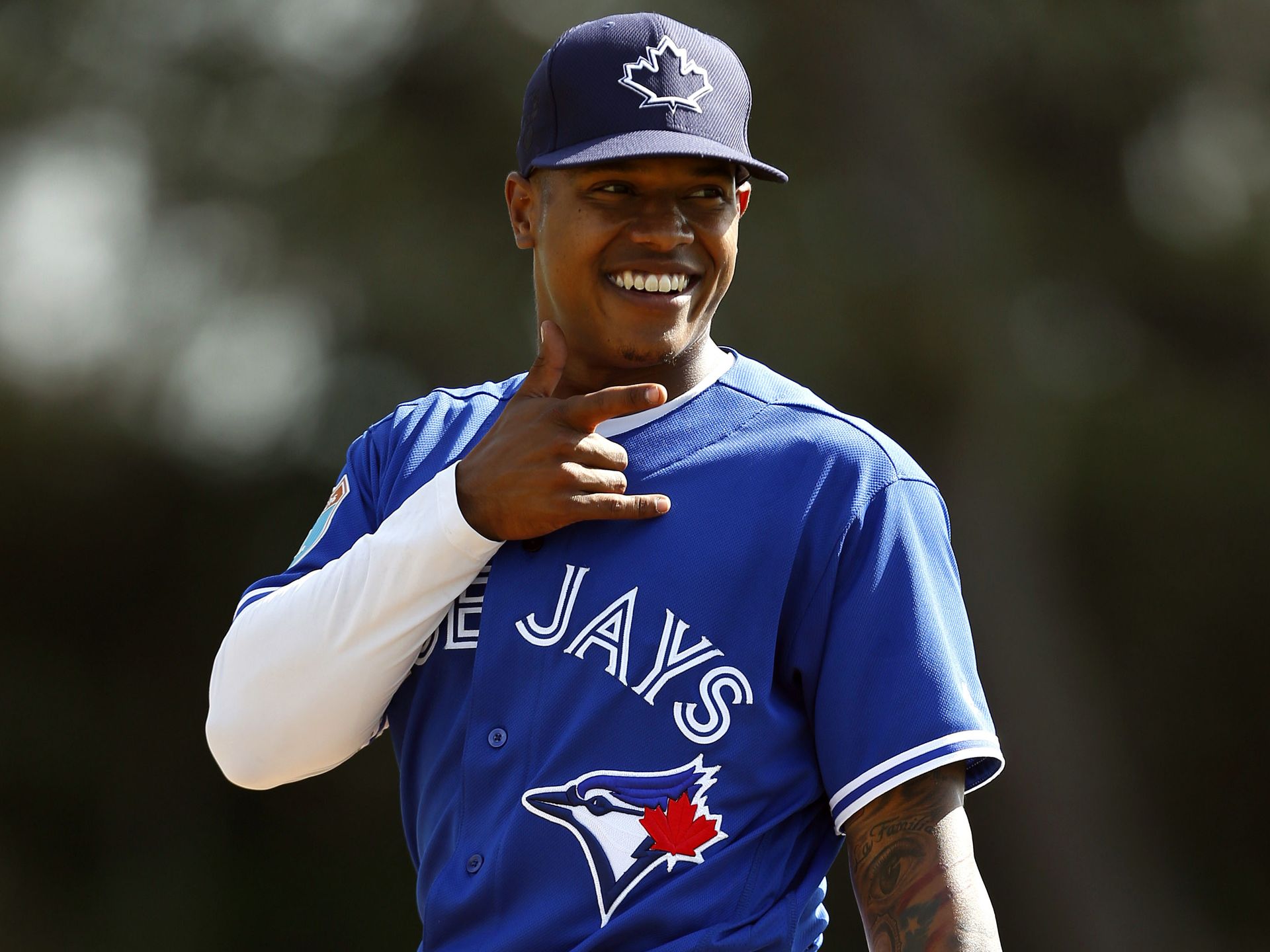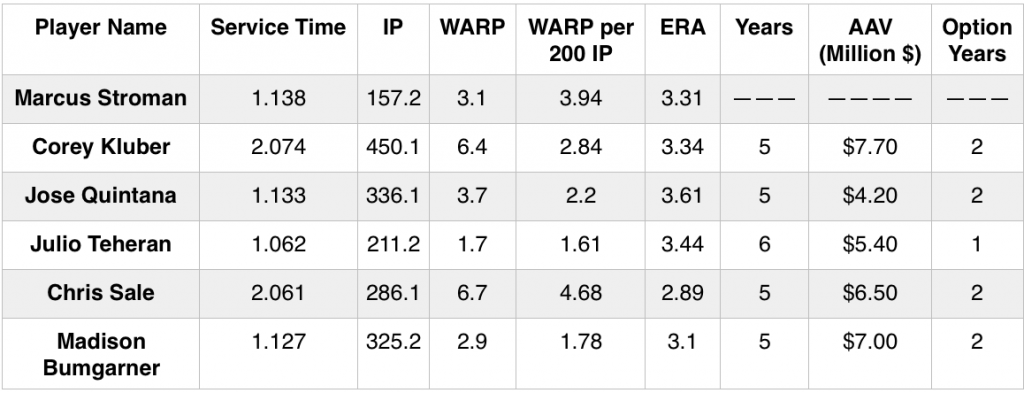Spring Training has begun in Dunedin, but the early talk around camp wasn’t about new acquisitions, new pitches, or players arriving in/out of shape. Instead, the chatter has been dominated by the potential free agency of two Blue Jays sluggers. This is certainly not a surprise, as both Jose Bautista and Edwin Encarnacion are able to walk at the end of the season and represent the most pressing contractual problem for the Blue Jays to solve. However, we shouldn’t be blind to the rest of the roster; there are 23 other players that will be on the team come Opening Day, and a couple with whom it could make sense to begin talking extensions. The most intriguing of these is the Blue Jays’ erstwhile ace, Marcus Stroman.
Pitchers like Stroman don’t come around often. He has legit number one pitcher upside, and has had nothing but success so far as a starting pitcher. He came back from a brutal knee injury in record time, and was chosen as the game 5 starter in the ALDS, over former ace David Price. He is, in all senses, a star in Toronto. But what people tend to forget is that the Duke grad has barely pitched in the big leagues, with a total of only 157 2/3 innings split between the rotation and the bullpen. However, because he was on the major league disabled list for five months, he has already accrued 1.148 years of service time. This means that if he stays on the major league roster for the entire season, he will for “super-two” status, and head to arbitration for the 2017 season.
Given the price of free agent pitching, and his pending arbitration, if the Blue Jays want to extend Stroman, now is the time to do it. He has yet to establish himself completely, and thus might still come relatively cheap. Blue Jays President Mark Shapiro went through a similar situation with Cleveland ace Corey Kluber last year, and told Cleveland.com that he likes to sign extensions like these during “the early part of spring training and a couple weeks ahead of it.” Kluber and the club eventually agreed to an extension on April 5th, the day before Cleveland opened the 2015 season. With that in mind, if the Blue Jays and Stroman are going to come to an agreement, it’s likely going to be done sometime in the next four weeks.
So what should an extension for Marcus Stroman look like? It’s a little bit complicated. Let’s start by looking at some comparable players who received extensions with similar service time.
All of these players signed extensions since the current CBA went into effect in December 2011, and all of them gave the team seven years of control. What you’ll notice right away is that all five pitchers had pitched significantly more often than Stroman at the time of their extensions. Because he has fewer innings at similar service time markers, using counting stats like WARP isn’t very conducive for comparisons. For example. by WARP, Stroman is fourth out of the six players, whereas if we look at WARP/200 IP, Stroman jumps up to second place behind Chris Sale. That paints a bit of a clearer picture, showing that based on quality of performance alone, Stroman is right in the class of the top-tier of the group above.
When it comes to actually paying for that performance, one could make an argument that Stroman deserves to be paid like Kluber or Madison Bumgarner. Yes, Kluber had the Cy Young season in 2014 before signing his extension, but the quality of Stroman’s outings has been almost identical, aside from relying on the groundball a bit more to get outs rather than strikeouts. The knock against Kluber was that he was already 28-years-old at the time of the extension, which means the Indians might be paying for some of the downside of his career after the age of 30. So instead, we turn to Bumgarner, where Stroman matches up almost perfectly in WARP, making him an excellent performance comp.
However, the situation is a lot murkier because we can’t just ignore Stroman’s lack of big league work. While not up there with Kluber, Madison Bumgarner still outpaces Stroman by a good 175 innings. With that in mind, none of those contracts, even Bumgarner’s, are perfect comps for the extroverted Blue Jays righty. To help build an extension model, we will first need to find a pitcher who was super-two eligible but also has lower overall innings totals. We can then use their first arbitration salary as a more accurate starting point.
Thankfully, this doesn’t require reaching too far into the past. Garrett Richards, a 27-year-old on the Los Angeles Angels, went through a very similar situation. After the 2014 season, Richards was super-two eligible but had only thrown 398 2/3 innings after he also missed some time with a knee injury. If Stroman throws 200 innings in 2016, as the team is expecting, that would bring him within almost 30 innings of Richards’ total. The comparison works on a numbers level as well. PECOTA pegs Stroman for an ERA of 3.77 in 2016, which when combined with his previous numbers, would bring his career ERA up to 3.55. At the time of his first year of arbitration-eligibility, Richards was at 3.66. That’s certainly close enough for our purposes, and Richards ended up settling with the Angels for $3,200,000 before a hearing.
If we combine Richards’ Arb 1 number with the raises in Bumgarner’s contract, and then toss in a bit of inflation, we should have the perfect ingredients for a Stroman extension. Bumgarner’s deal was worth 5 years with a $35 million guarantee, buying out his last year of league minimum salary, his three years of arbitration eligibility, and one year of free agency. The contract also had two team options tacked onto it at a value of $12 million each, with some performance based incentives built in. The structure is as follows:
Between seasons 2 and 3 of the contract, he received an 80% raise. From then on, his raises were 44%, 18%, and then another 4% for his two option years.
If our Stroman extension, to help convince him to take the contract, he will get a slight raise from his current salary in 2016 to $750K. Then in 2017, he would receive a salary based on the Richards Arb-1 test case, with $300,000 tacked on to account for the fact that Richards signed two years ago. For the remaining years of the contract, we apply the percentage raises from Bumgarner’s deal above, then add in a slight factor of inflation. In 2012, the average MLB salary was $3.21 million, while in 2015 it was $3.84 million. This represents 120% of the 2012 total, so we’ll multiply all of the expected salaries by a factor of 1.2. The breakdown would look like this:

After all of that, we end up with a 5 year, $35.55MM deal with an upside of 7 years, $62.25MM. Of course, Stroman would have to be willing to sign such a contract, as like all of these early extensions, it is quite team friendly if he continues to perform. However, the benefit would be that he guarantees himself a solid amount of money over the next five years to go with the security in knowing that if he blows out again, he’s still set for life. The deal is also structured in such a way that Stroman would hit the free agent market by age 31, which is still plenty young enough for a pitcher to get a five or six-year deal.
For the Blue Jays, the benefit is obvious: they get seven years of a cost-controlled front of the rotation starter, they avoid the pains of arbitration, which can unevenly award salaries, and will be able to more accurately predict their payroll going forward. Furthermore, the club could use some good PR if they fail to extend Bautista or Encarnacion this spring, and signing everybody’s favourite young player is one way to do it.
Will the Blue Jays sign Marcus Stroman to an extension? I don’t know. But if they do, it should look something like what you just read and the Blue Jays will be getting a great player.
Lead photo: Butch Dill-USA TODAY Sport


